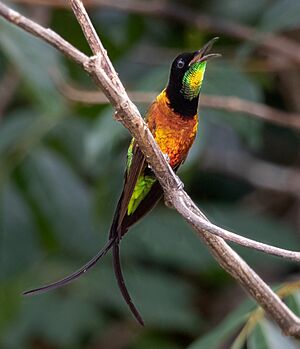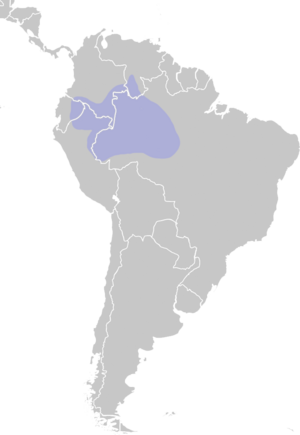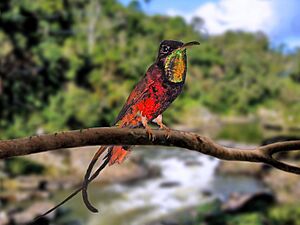Fiery topaz facts for kids
Quick facts for kids Fiery topaz |
|
|---|---|
 |
|
| Male in Acre, Brazil | |
| Conservation status | |
| Scientific classification | |
 |
The fiery topaz (Topaza pyra) is a beautiful hummingbird known for its bright, shiny feathers. It lives in northern South America. This amazing bird eats nectar from flowers and also catches small insects.
Contents
About the Fiery Topaz
The fiery topaz belongs to a group of hummingbirds called Topaza. These birds are some of the largest hummingbirds in the world. Adult males can grow up to 23 centimeters (about 9 inches) long and weigh up to 12 grams (about 0.4 ounces).
Family Tree
The Topaza group is closely related to another group of hummingbirds called Florisuga. Together, they form a very old branch of the hummingbird family. This means they separated from other hummingbirds a long, long time ago.
Is it a Separate Species?
Scientists recognize two main types of topaz hummingbirds: the fiery topaz (T. pyra) and the crimson topaz (T. pella). Some scientists think they might be the same species, while others believe they are different.
People who think they are different species point out that the fiery topaz and crimson topaz have clear differences in their colors and body shapes. These differences stay the same no matter where the birds live. Also, no one has ever found a mix of the two types. The mighty Amazon River seems to act like a natural barrier, keeping the two groups apart and helping them stay distinct.
Subspecies
The fiery topaz itself has a few different types, called subspecies:
- Topaza pyra pyra: Found in southeastern Colombia, eastern Ecuador, northeastern Peru, and southern Venezuela.
- Topaza pyra amaruni: Lives in the western parts of the Amazon rainforest in Peru and Ecuador, near the Napo River and Río Corrientes.
- Topaza pyra pamprepta: Found in eastern Ecuador, around the Napo River and Río Suno region.
What Does it Look Like?
The fiery topaz can grow to about 19 centimeters (about 7.5 inches) long. Male and female fiery topazes look quite different from each other. This is called sexual dimorphism. Both have dark brown eyes, but males are usually bigger than females.
Male Fiery Topaz
Male fiery topazes are truly stunning! Their backs, lower chests, and parts of their wings are a bright, shiny orange-red. This color becomes more orange on their bellies and then changes to yellow-green or green on their upper tail feathers.
The top and sides of their heads are a deep, velvety black. Their throats sparkle with iridescent green and orange-red colors. They have a thick, curved, and fairly short beak, about 25 millimeters (1 inch) long. Males also have two special long central tail feathers, which are about 64 millimeters (2.5 inches) long. Their beaks are black, and their feet are gray.
Female Fiery Topaz
Female fiery topazes are also beautiful, but in a different way. Their upper bodies are a shining green. They have a coppery-red patch on their throat, outlined by a thin orange-yellow-green band. The rest of their head is a medium to bluish-green, and their chest is less blue. Their tails are purplish-red.
Like the males, females have black beaks, but their feet are orange or flesh-colored. The feathers under and over the tail have orange highlights in males, but are blue-green in females.
The fiery topaz looks a lot like the crimson topaz. However, you can tell Topaza pyra apart because it has a shorter beak, longer wings, a longer tail, and thinner tail feathers compared to Topaza pella.
Where Does it Live?
Topaz hummingbirds only live in the Amazon rainforest. The fiery topaz has a very large home range. You can find T. pyra in Brazil, Colombia, Ecuador, Peru, and Venezuela.
Its Home in the Amazon
Its natural home is in warm, wet lowland forests, usually at elevations up to 500 meters (about 1,640 feet) above sea level. These birds like to stay high up in the treetops, especially at the edges of forests and in clearings near water. They are often seen close to river banks.
How Does it Behave?
We don't know a lot about the daily lives of fiery topazes because they are hard to observe in the wild. However, people have seen them feeding and interacting with each other near rocky streams in the hills where they live.
Like other hummingbirds, they build their nests in small, cup-shaped structures covered with lichen, often low over the water. Male fiery topazes are quite protective of their feeding areas and will often chase away other birds that come too close to flowering plants.
Food and Feeding
More studies are needed to learn about what these birds eat. But we do know that the fiery topaz mainly eats nectar. It feeds from flowers, vines, and plants that grow on other trees (called epiphytes). They prefer to feed on high-up flowering vines. They also eat small insects.
Is it in Danger?
The fiery topaz is listed as a species of "Least Concern" by conservation groups. This is because it lives across a very large area. Even though its population seems to be shrinking, it's not decreasing fast enough to be considered in serious danger right now. We don't know the exact number of fiery topazes, but there are likely more than enough to avoid being classified as vulnerable.




